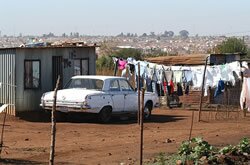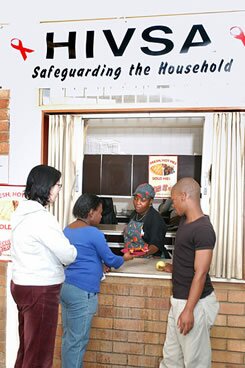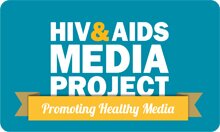New Ways of Perceiving the Health Beat
Traditionally, health has been seen as a junior, female beat in South African journalism.
Not only is health seen as being a women's beat, but many newspapers, radio stations and TV channels have a particular view of health (excluding HIV) as "women's stuff" that focuses on dieting, vitamins, natural remedies, alternative therapies and how to deal with "family illnesses".
Yet in newspaper and magazine readership surveys, both men and women consistently indicate their interest in health issues. In addition, "Men's Health" magazine, which was launched in 1997, claims that it has 292 000 regular monthly readers, 44% earning over R12 000 a month.1
I want to challenge journalists to look at health differently. Health offers opportunities to connect with readers of both genders, all races and most religions. In addition, health can be used as a highly effective tool to analyse contemporary South Africa and narrative journalism— a type of storytelling that contacts and holds readers through visual details, credible characters, action and an authoritative authorial voice— often provides an excellent method for telling health stories.
What is Health?
Dictionaries define health as a state of physical and mental wellbeing and the condition of being disease-free. We in the media have tended to see health either in a narrowly medical way, focusing almost exclusively on physical conditions and diseases, or by looking at "new age" alternative therapies.

Mental health tends to be focused on motivational issues in terms of how our attitude affects our performance. There is still a great deal of stereotyping of people with mental illnesses. There is little conscious acknowledgement that "social fabric" issues such as rape and alcohol abuse are health issues.
We seldom make connections between levels of service provision and health. But whether communities have access to clean water, decent sanitation and housing is directly linked to their wellbeing. In 2000, for example, there was a serious cholera outbreak in northern KwaZulu-Natal. This was generally reported in the media in the narrowest of terms, as a medical emergency. It later emerged that the epidemic was directly related to the introduction of pre-paid water meters, the continual malfunctioning of these pre-meters and waits of up to six weeks for the municipal staff to fix broken taps. These problems drove many people to get water from the uMhlathuze River, which was identified as the original source of the cholera bacteria. Lack of proper sanitation in Ngwelezane and limited clean running water meant that cholera bacteria, which is spread through contaminated water and food, was able to spread rapidly from person to person.2

In 2002, the countries first HIV and AIDS household survey was conducted by the HSRC/Nelson Mandela Foundation. This survey found that people living in informal settlements were the most vulnerable to HIV infection. Although those living in rural areas were a lot poorer, it was the instability and transitional nature of informal settlements, where bonds of community and family are not that tight, that made people more likely to engage in risky sexual behaviour.4
Last year, a study of eight villages within a 20km radius in Sekhukhuneland in Limpopo by Wits University's Rural AIDS and Development Action Research Unit found a variation in HIV-prevalence from 1%-46%. In trying to understand what made one area more vulnerable to HIV than another, researchers concluded that communities were more at risk if their village was on a main road, near a mine or main trading area. Men were particularly at risk if they lived near bars or in villages with a high proportion of sex workers. Income and educational levels were found to be irrelevant.
So living conditions and location are closely tied with health, and when we try to capture the texture of people's everyday lives, finding out where and how they live can tell us a great deal about the health risks they might face.
Health as political analysis
Worldwide, health indicators are acknowledged as an accurate way of measuring how developed a country is. Statistics about how we are born, live and die speak volumes about a society. The infant mortality rate (how many babies die per 1000 live births before the age of one), under-five mortality rate, maternal mortality rate (how many women die during childbirth), life expectancy and causes of death are important indicators of the health of a nation.

Health indicators will tell you far more than any politician would ever dare to. They can provide direct insight into the quality of everyday life of ordinary South Africans. This is the real "body politic"!
I believe that our nation's vital statistics open the doors to thousands of narrative possibilities as well as offering a powerful and direct way of assessing how well we as a nation are progressing, bypassing all party political rhetoric.
So what do our health statistics say about us?
For a start, more children under five are dying now than they were under the apartheid regime. In 1975, the year before Hector Peterson and hundreds of other Soweto schoolchildren were shot dead by apartheid's police, for every 1000 children born, 89 would be dead by their 5th birthday.
By 1998, the new democratic government had reduced this to 59 deaths by the age of five out of every 1000 children born. But in 2000, 95 children per 1000 born were dead before they turned five.3
In addition, we have a completely abnormal adult death pattern for a developing country such as ours. The Bureau for Market Research at Unisa tells us that three times the number of women aged between 20 and 30 and double the number of men aged 30 to 40 are dying than should be for a country such as ours.
If any politicians were to stand up in Parliament and say that small children and adults under 40 are worse off now than prior to 1994, they would probably be condemned as being anti-patriotic racists. Some of the AIDS denialists, who dispute that HIV exists but love to boast of their cosy relationship with our president, have chosen to cast doubt upon these statistics. But the Medical Research Council has been counting bodies in mortuaries. While there are still disputes about the causes of death, no-one can hide the bodies or disguise how young those who are dying are.

Outside of the context of the HIV epidemic, these figures would be a shocking indictment on our democratic government. But for those of us who both accept that HIV causes AIDS and that the ANC government has made genuine progress is improving the living conditions of millions of South Africa, these statistics can only be attributed to the AIDS epidemic, which may prove to be a more formidable enemy than apartheid.
By 2002, AIDS was responsible for 40% of dead adults. The Actuarial Society of Southern Africa predicts that 47% of deaths in 2005 will be AIDS-related. AIDS is overwhelming communities countrywide and the government's HIV and AIDS comprehensive treatment and care plan (which includes providing antiretroviral drugs to those who need them) is being rolled out far too slowly and without proper leadership or management.
While AIDS is by far our biggest killer, almost as many people (37% in 2000) are being killed by a combination of chronic diseases such as heart attacks, strokes and hypertension. These chronic conditions are almost all directly associated with poor diet, lack of exercise, smoking, alcohol abuse and being overweight— all indications of a modern, westernised lifestyle.
Chronic disease experts also blame our worsening health and thickening waistbands on the rapid expansion of fast food outlets in the country after 1994. Prosperity has come to mean being able to offer your visitor a carbonated soft drink, to give your children white bread for school or to go to KFC or McDonalds as a treat. The links between success and consumption are cemented by the advertisements that we run, as producers of fizzy drinks, fast foods, alcohol and cigarettes seek to colonise new markets in the developing world.

Aside from the killer combinations of infectious and chronic diseases, we are a violent nation. A Cuban doctor working in a hospital in Kimberley, which has one of the highest incidences of assault in the country, told me that stabbing one another is South Africa's "national sport".
Homicide and violence is our second biggest killer overall (7.5%). About one in five teenagers will die of injuries, the vast majority (61%) of which were deliberately inflicted on them by other people. Road accidents (21%) and suicide (10%) are the other main violent killers of our teens. Very often those who suffer violent deaths are young men. Very often excessive alcohol abuse is a factor in homicides and accidents. We assume that the "born free" generation is better off than their parents, but these health statistics show that young people are under intense pressure.
We are also still a nation divided. Health indicators demonstrate perfectly President Thabo Mbeki's "two economies" thesis. Take a 2002 youth survey of school children in Grades 8-11. Over one in five African and coloured youth were either underweight or stunted. In contrast, one in three Indian and white teens were either overweight or obese.
The kind of health care you can get is also determined by where you live and what you earn. Limpopo is so short of doctors that a woman giving birth in a public facility will have a one in 10 chance of ever being seen by a doctor.
But a woman giving birth in a private health facility in a major urban area will have a highly medicalised birth, attended to by specialists and an almost 40% chance of a Caesarian (against an international norm of up to 15%). What does this mean? Surely not that women in Johannesburg's northern suburbs have abnormally small pelvises?






